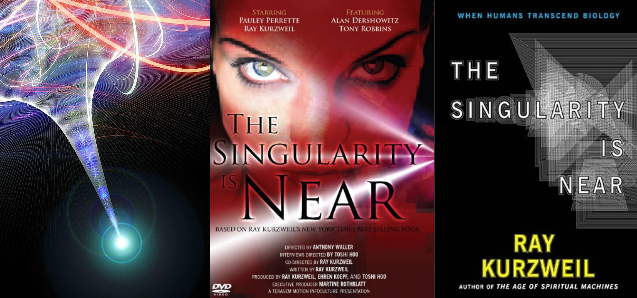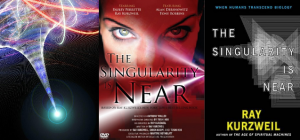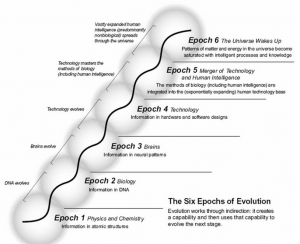
“Startling in scope and bravado.” – The New York Times
“An exhilarating and terrifyingly deep look at where we are headed as a species… Kurzweil makes a compelling and indeed, moving case for his view of the future.” – The New York Sun
“A radical and optimistic view of the future couse of human development by “the best person I know at predicting the future of artificial intelligence.” – Bill Gates
Hold on to your trousers, the future is here! Or if it isn’t, after reading this book it will certainly feel as if it’s rushing towards us like an asteroid or minor moon on a head-on collision course with humanity. Forget talk about flying cars, robot maids, orbit cities and other futuristic tosh dished out to us by cartoons like The Jetsons. The future envisioned by Ray Kurzweil and portrayed in his book, The Singularity is Near, is vastly more intellectually appetizing and infinitely more breath-taking.
We are now on the verge of the most transforming and thrilling period in human history. Ray Kurzweil’s thesis is that exponential progress in the fields of Genetics, Nanotechnology, and Robotics (GNR) combined with inspiring breakthroughs in the field of neuroscience, space exploration, and quantum computing will usher in an era that will revolutionise our understanding of what it means to be human.
So, who is Ray Kurzweil? If most people don’t know they may be forgiven. It’s hard to keep track of all the thinkers and innovators out there especially when Madonna is constantly having slip-a-nip moments on stage and David Beckham is getting another tattoo and Brangelina are shopping for another black baby. The mainstream media obviously know what the masses want.
Ray Kurzweil has received eighteen honorary doctorates; is a senior fellow of the Design Futures Council; and is a member of the U.S. Army Science Advisory Board. He is an innovator, an artificial intelligence guru, an inventor, a proponent of trans-humanism, and a futurist with the uncanny ability of making true predictions about the future of technology. He forecast the demise of the Soviet Union; correctly predicted that computers would beat a chess grandmaster by 1998; foresaw the explosive growth of the internet in the 1990s; and numerous other predictions in the field of technology, genetics, and computing. Obviously, a few of his predictions haven’t come to pass, but the success ratio of his predictions is extraordinarily high. The operative word here is ‘predictions’. Kurzweil makes predictions not prophecies. That’s why it’s disingenuous of his detractors to call him a pseudo-religious prophet. Predictions are based on hard data, cold facts, and current trends. An astute individual may use these to extrapolate where things are headed. Predictions are not set in stone because unforeseen and unforeseeable events can always affect the future. Prophecies, on the other hand, are more often spouted by the religious-minded and it’s based on the premise that the future is fixed and unchangeable. So, an example of a prediction (based on current data and current technological trends) is to say that we will have $100 laptops by 2015. A prophecy is that the world will end on 23 Dec 2012. – Two very different ways of considering the future. Ray Kurzweil’s prediction is that singularity will happen by 2045—frighteningly sooner than anyone would imagine.
So what is the singularity? Well, we need to distinguish technological singularity from the singularity of physics. The equations in physics tell us that we can peer past the event horizon of a black hole and at the centre of a black hole is an infinitely dense point of infinite matter. At this point all equations break down and it is currently impossible to predict what happens at singularity. The technological singularity that Ray Kurzweil talks about is a point in the future where exponentially growing technologies will usher in an age of greater than human intelligence and increasing merger between biological and artificial intelligence. Among the many things this would involve would be the ability to reverse-engineer the brain, upload human consciousness into computers, and essentially live in virtual worlds for ever. It will be a time when biological enhancements, genetic manipulation, machines with access via the Internet to all human knowledge and processing speeds approaching the speed of light. This will lead to “technological change so rapid and profound it represents a rupture in the fabric of human history.” As pre-singularity beings it will be nearly impossible for us today to predict what changes this will lead to in a post-singularity world.
Two factors will play a key role in leading to the singularity: the law of accelerating returns and the exponential growth of technology. The key word here is ‘exponential’. Most people are evolutionarily conditioned to perceive progress in a linear fashion (progress by repeatedly adding a constant) as opposed to exponential progress (progress by repeatedly multiplying by a constant). What this means is that instead of seeing a hundred years of progress in the next 100 years, we will instead witness on the order of twenty thousand years of progress in that period of time. Kurzweil goes on to give numerous examples of exponential growth—from internet traffic; magnetic data storage; the price of dynamic RAM; and the cost of computer transistors; to microprocessor clock speed; growth in supercomputer power; and DNA sequencing costs. (It took 15 years to decode the HIV virus compared with the SARS virus which took just 31 days).
There is no hint that the rate of technology growth will slow down. IBM’s Supercomputer, Watson, recently beat the best human contestants at Jeopardy. What this mean is that by 2050 $1,000 of computing will exceed the processing power of all human beings on Earth. By 2080, for this same amount of money we will have computers that will outperform the processing power of ten billion human brains thinking for ten thousand years—and it will do it in ten microseconds. And there’s no stopping this growth. We will continue to generate computing that will soon allow us to use the very fabric of space to infuse the entire universe with intelligence and information processing.
Heady, giddy, scary stuff for some; inevitable human destiny for others.
Ray is quite comfortable discussing these mind-boggling statistics. He’s also careful to lay out how he reaches his conclusions and predictions. For instance, he points out that a 2 pound rock has on the order of 1027 bits of information encoded in the state of its atoms and about 1042 computations per second represented by the activity of its particles. He then goes on to extrapolate the computational capacity of the human brain (based on inter-neural connections, neurotransmitter concentrations, and synaptic and dendritic nonlinearities).
So where does this lead to? A picture speaks a thousand words. Here’s a representation of how information storage has been evolving. We are now on the cusp of entering epoch 5 where humans are starting to merge with technology (for instance, our smart phones already function as an external cortex—we outsource a part of our cognition to our iPhone.)
In the rest of the book, Kurzweil goes on to discuss the real possibility of achieving the computational capacity of the human brain and how to reverse engineer it. He elaborates on the difference between the brain and computers and elaborates on different models of the brain. It’s all here: programmeable blood; smart weapons; full-immersion virtual reality; smart dust; humans 3.0; space exploration; uploading consciousness; overcoming death…
In the latter half of the book, he focuses on three overlapping revolutions in the fields of Genetics, Nanotechnology, and Robotics. And he finally concludes on the impact of these revolutions on the human body, the human brain, on human longevity, on warfare and on the intelligent destiny of the cosmos. Kurzweil is at pains to elaborate on the threats posed by technology and the barriers to achieving Singularity.
Kurzweil has come in for criticism from various quarters. His final chapter deals with detailed refutations of the objections raised by his detractors.
The underlying message of this book is that the essence of being human is not our limitations—it’s our ability to reach beyond our limitations. As Kurzweil says, “We didn’t stay on the ground. We didn’t even stay on the planet. And we are already not settling for the limitations of our biology.” The purpose of life in his view is to create and appreciate ever-greater knowledge.
All in all, this is an exhilarating, optimistic, and vastly informative book. Anyone curious about the future of humanity and trends in technology will be well advised to read this book. Watch out for the future! It’s closer than you think!

